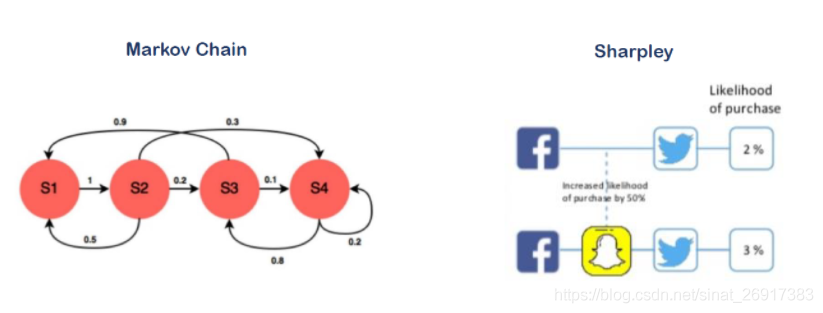Attention-RNN来做多触点归因模型
代码引用自:jeremite/channel-attribution-model 不过之前作者的库没把数据集放上来,我就看着作者的博客文档,自己造了一个可以跑的数据集。 我的博客: 多渠道归因分析(Attribution):用attention-RNN来做归因建模(附代码demo)(五)
之前几篇多渠道归因分析应该算是比较通用的一些方法论:
- 多渠道归因分析(Attribution):传统归因(一)
- 多渠道归因分析:互联网的归因江湖(二)
- 多渠道归因分析:python实现马尔可夫链归因(三)
- 多渠道归因分析(Attribution):python实现Shapley Value(四)
- 多渠道归因分析(Attribution):用attention-RNN来做归因建模(附代码demo)(五)
之前在查阅资料的时候,有看到一篇更进阶的,用深度学习来解决问题, 论文可参考18年的一篇: Deep Neural Net with Attention for Multi-channel Multi-touch Attribution
我们来看这篇以及品鉴一下关联代码: 官方:channel-attribution-model
我把可以跑通demo代码放在自己的github之中:mattzheng/Attention-RNN-Multi-Touch-Attribution

一种基于注意力的循环神经网络多点触摸归因模型,以监督学习的方式预测一系列事件是否导致转换(购买)。 模型可以输出不同节点的重要性(LSTM的),同时还结合了非常关键的信息,将用户背景信息(如用户人口统计和行为)作为控制变量,以减少媒体效应的估计偏差。 来说明几个特色:
- LSTM 来捕捉长路径模式
- RNN with Attention 将时间衰减作为attention加入
- customer profile — embedding layer + ANN:额外融入用户属性信息
- 还可以输出每个触点的重要性(即LSTM的节点)


- 路径模块带有attenion(时间衰减)
- 用户模块,属性embedding之后输出 最后两者add()在一起做输出。
路径变量作为输入数据被发送到LSTM层,并获得每个路径变量的输出。LSTM体系结构能够捕获通道数据的顺序模式。
这个环节是节点模块的比较有意思的模块:
The time-lapse data are scaled and will be used in the revised softmax function in Attention layer.

一个简单的全连接神经网络来处理客户数据。这部分非常简单,只有几个密集的层。 之前用户编码会用one-hot encoding,这里使用的是embedding layer自训练。
嵌入层 Embedding:将正整数(索引值)转换为固定尺寸的稠密向量。
例如: [[4], [20]] -> [[0.25, 0.1], [0.6, -0.2]]
来看一个keras官方的例子[Embedding]:
model = Sequential()
model.add(Embedding(1000, 64, input_length=10))
# 模型将输入一个大小为 (batch, input_length) 的整数矩阵。
# 输入中最大的整数(即词索引)不应该大于 999 (词汇表大小)
# 现在 model.output_shape == (None, 10, 64),其中 None 是 batch 的维度。
input_array = np.random.randint(1000, size=(32, 10))
model.compile('rmsprop', 'mse')
output_array = model.predict(input_array)
assert output_array.shape == (32, 10, 64)
路径模块和客户属性模块,输出到另一个dense层,然后由sigmoid激活函数到最终,0/1分类
out_att = Dense(32, activation = "sigmoid", name='single_output')(c)
# Step 3: import embedding data for customer-ralated variables
input_con,out_control = self.build_embedding_network()
added = Add()([out_att, out_control])
github中的代码两个输出直接相加add(),不是conatenate()
- RNN-attenion模型,96% accuracy 和0.98 AUC
- markov模型,0.86 AUC
我将使用性能最好的模型来计算分配给每个通道的权值。基本上,对于每一个送入模型的观测数据,如果输出概率大于0.5(这意味着该观测将被归类为转换),我会从Attention层提取权值,并将其累加到相应的通道。
在得到每个渠道的权重后,我们将使用下面的公式来分配营销预算。
哪些营销渠道在推动转化率和销售额,意味着你可以更好地将营销资金分配到最有效的渠道上,并更好地跟踪潜在客户的互动

如果有顾客点击了很多路径内容还没转化,可以通过模型得到他购买的可能性。
例如,如果你的公司也关心每个渠道其他转化情况(如电子邮件活动中的广告的点击率),你将在LSTM之上添加更多的层来实现这一点,如下图所示。
此外,您还可以预测一次购买的平均支出或金额,这可能会使分配权重更准确,也可以提供您关于调整供应链的信息。可以参考上文的输出接入:average spending
根据每个客户路径的转换概率排名,我列出了最具影响力的N条路径。 代码如下:
def critical_paths(self):
prob = self.model.predict([self.X_tr,self.s0,self.time_decay_tr,self.X_tr_lr.iloc[:,0],self.X_tr_lr.iloc[:,1],
self.X_tr_lr.iloc[:,2],self.X_tr_lr.iloc[:,3]])
cp_idx = sorted(range(len(prob)), key=lambda k: prob[k], reverse=True)
#print([prob[p] for p in cp_idx[0:100]])
cp_p = [self.paths[p] for p in cp_idx[0:100]]
cp_p_2 = set(map(tuple, cp_p))
print(list(map(list,cp_p_2)))
在文章How to implement an Attention-RNN model into solving a marketing problem: Multi-Channel Attribution中没有放出数据,所以笔者自己造了按博文自己造了几条,代码可见:mattzheng/Attention-RNN-Multi-Touch-Attribution
- total_conv就是最后是否转化
- last_time_lapse,节点访问时间经过,放入的是路径模块,作为attention模块,不过这个样式我自己造的时候也有点不确定,是否每个节点对应,可以自由灵活调配
- marketing_area 、 tier 、 customer_type都是用户属性类型,这里自由发挥,可以很多
How to implement an Attention-RNN model into solving a marketing problem: Multi-Channel Attribution











